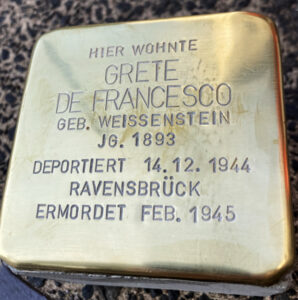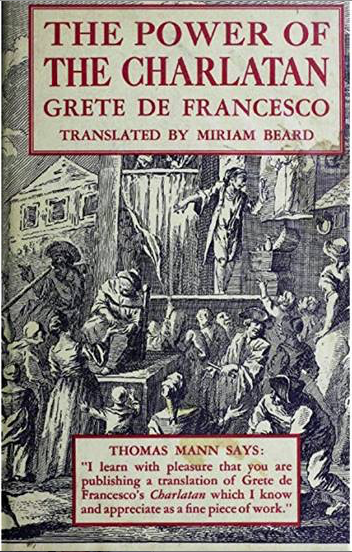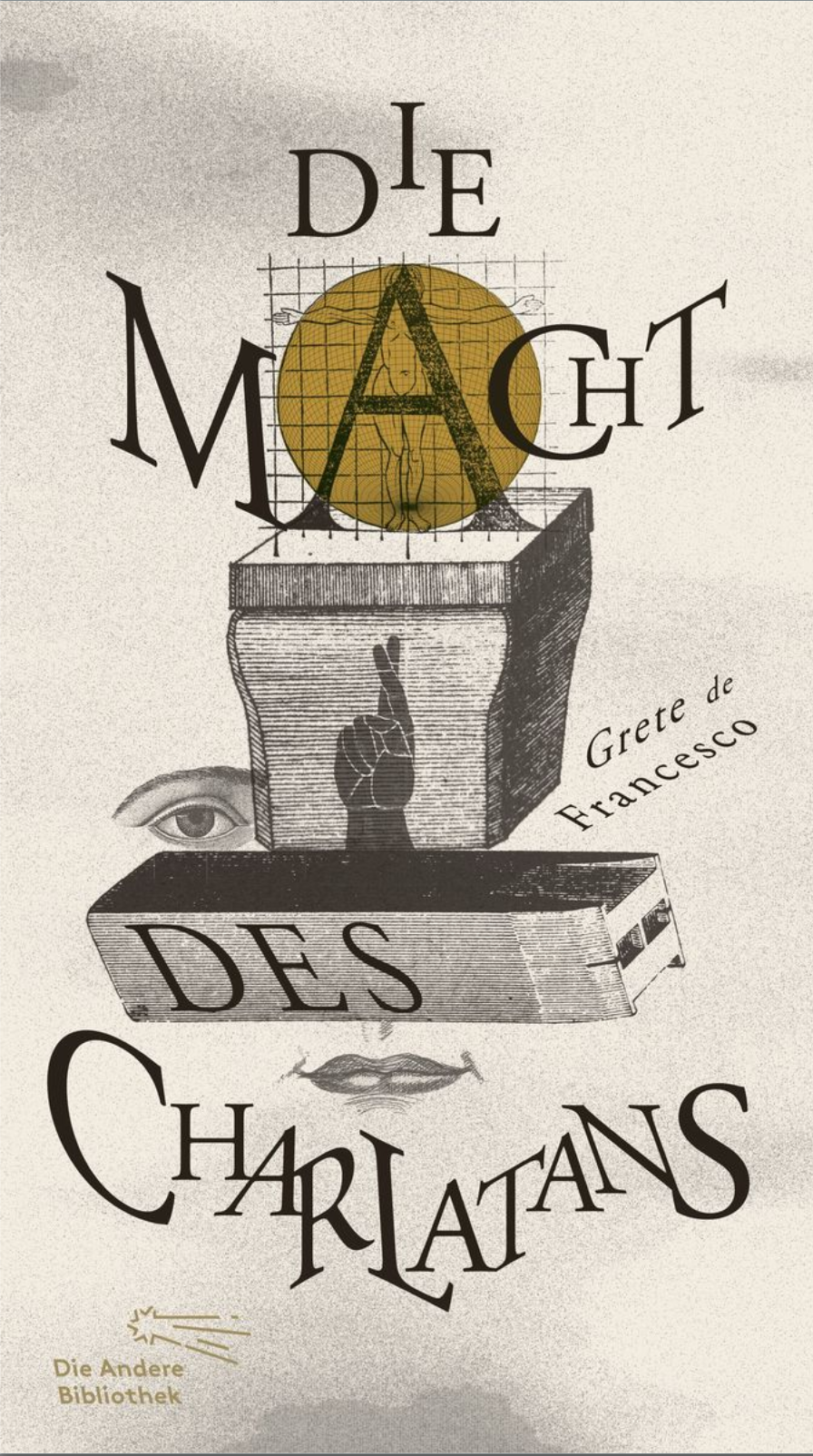Margarethe WEISSENSTEIN was born in Vienna on November 5, 1893. She was the oldest of three daughters born to the Jewish couple Else Kuffler Weissenstein and Emanuel Weissenstein. Her father, Emanuel Weissenstein, was the director general of the United Jute Mills company of Vienna and Budapest.
The High Life Almanac of Vienna’s high society counted the Weissenstein family among those Jews who were completely assimilated into the upper levels of the educated bourgeoisie of the city and reported that they lived at 39 Felix-Mottl-Straße in the elite Wien-Döbling neighborhood.
In 1928 Else Weissenstein and her daughters Margarethe, Elisabeth (Lisa) and Dorothea acquired the Salzburg villa at 11 Franz-Josef-Straße (16 Faberstraße) that had been a sanatorium since the days of the Habsburg monarchy. They called it the Hromada Sanatorium after its new director and chief surgeon, Lisa Weissenstein’s husband Dr. Gebhard Hromada.
In September 1932 the Sanatorium Hromada had a very prominent patient: Winston Churchill, who was suffering from paratyphoid. As there was no Jewish hospital in Salzburg the city’s Jews relied on the Hromada Sanatorium in the Andrä-quarter until the violence of 1938.
The Nazi regime classified the villa as »Jewish property«, but for some unknown reason it wasn’t expropriated outright. Instead it was placed in receivership based on a lien placed on the property by the German government against an enforceable claim under the so-called Reichsfluchtsteuer – the »flight tax« imposed on Jews who left the territories of the Third Reich. The former Hromada Sanatorium served the German Army as a »hygiene research institute« or »examination site« (a vague designation that leaves its actual use unclear).
Emanuel Weissenstein died in Vienna at the age of 79, on May 31, 1938 when Austria was under Nazi rule. He is buried in the Döblinger Cemetery. His wife, Else Weissenstein, and her two married daughters, Elisabeth Hromada and Dorothea Potter, managed to escape to South and North America.
The life of the older daughter Margarethe had become unstable after the collapse of the Austro-Hungarian monarchy. There are various reasons for this (some of which have not yet been identified), specifically her marriage and the death of her child. Margarethe Weissenstein, a graduate of a teaching and research institute for photography who was still living in Munich during the First World War, got married on October 10, 1916 in the Catholic parish church of Vienna-Döbling (where the Weissenstein family lived).
Margarethe’s new husband was Julius (Giulio in Italian) De Francesco, who had been born in Pergine (near Trent, which is now in Italy, but belonged to Austria-Hungary until 1918), on September 21, 1891. Julius was the son of a district school inspector and was an engineer and technician – as well as a Lieutenant in the Tirolian Kaiserjäger regiment who had earned a silver medal first class for bravery.
In Munich, Grete DE FRANCESCO gave birth to a son named Peter on June 5, 1918. After the end of WWI, the De Francescos lived at Greta’s parents’ house in Vienna-Döbling. Their four-year-old son Peter became ill and died from Peritonitis in the Rudolfinerspital on March 15, 1923. Peter was buried in the Döblinger Cemetery (according to the death register of the Döbling Catholic parish).
Grete DE FRANCESCO’s husband, who had been born in Trentino, Austria, decided not to opt for Austrian citizenship after the collapse of the monarchy. Because wives were then assigned the citizenship of their husbands Grete also became an Italian citizen rather than an Austrian one (that took place before Italy became a fascist dictatorship under Benito Mussolini).
The now Italian couple had trouble gaining a foothold in Vienna. The next station of their life together was unclear until recently, but now we have learned something about it. From 1925 to 1927 an anonymous reporter identified as »our correspondent«, reported on theater life in Fascist Italy for the daily newspaper Neues Wiener Journal. On February 18, 1926 it reported:
Pirandello antwortet … Die neueste Mailänder Sensation.
[Pirandello replies … The latest Milanese sensation]
It seems as if the author of the »Italian theater letter« about Luigi Pirandello might have remained anonymous for political reasons. But there was also another possibility: that »our correspondent« was a woman.
And that’s something that becomes clear when we note that when a play (The life that I gave you) by Luigi Pirandello premiered in Vienna’s Burgtheater on January 16, 1926, an essay by Grete DE FRANCESCO about her »compatriot« Pirandello appeared in the program booklet.
There can be little doubt that »our correspondent« in Milan was Grete DE FRANCESCO because when the last »Italian theater letter« appeared in the Neues Wiener Journal on October 19, 1927 and Luigi Pirandello left Fascist Italy and went »in exile« to Berlin in 1928, we find that Grete DE FRANCESCO had also moved to Berlin.
In 1928, the new owners of the villa at 11 Franz-Josef-Straße (Frau Else Weissenstein and her daughters Margarethe, Elisabeth and Dorothea) registered their ownership in the property registration records of Salzburg – and the address of daughter Margarethe DE FRANCESCO was listed as »Private in Berlin-Friedenau«. So, Grete DE FRANCESCO was also living quasi »in exile«. Later waystations included: Frankfurt am Main, Paris, Basel and Milan again, her last self-chosen address.
Grete DE FRANCESCO studied at the German University of Politics in Berlin and wrote a master’s thesis on Italian fascism. On November 17, 1930 an article on »The Politics of Science« by Grete DE FRANCESCO »from Berlin« was published in the Neuen Wiener Tagblatt.
Her political orientation expressed itself – somewhat cautiously – in a review of the Soviet documentary film TURKSIB, about the railway construction of Turkestan to Siberia (Neues Wiener Tagblatt, February 17, 1930).
Grete DE FRANCESCO also published in the Berliner Tageblatt, the Frankfurter Zeitung and until 1940 in the Basler Ciba-Zeitschrift. She was undoubtedly a prominent anti-fascist researcher, journalist and author. Nonetheless, her last address was in Mussolini’s fascist Italy: 5 via Renato Fucini in Milan.
This address is on a letter that Grete de Francesco wrote to Thomas Mann on October 16, 1937, letting him know that he would receive her book on Die Macht des Charlatans [The Power of the Charlatan] from Basel. She clearly wanted the Nobel prize winner Thomas Mann, whose novel Mario and the Magician had been set in fascist Italy, to review her book.
Grete DE FRANCESCOS highly acclaimed Die Macht des Charlatans, was even reviewed positively several times in Austria, which was politically oriented towards Italian fascism, most recently in the Neuen Wiener Tagblatt on March 13, 1938. Writing from exile Walter Benjamin called it – a book that is the internationally recognized standard reference work on the subject of »charlatanism«. The English translation, published in 1939, featured praise from Thomas Mann on its cover:
I learn with pleasure that you are publishing a translation of Grete de Francesco’s Charlatan which I know and appreciate as a fine piece of work.
The life of Grete DE FRANCESCO was under massive threat in Italy, which had been occupied by the German Wehrmacht and the SS since September 1943. She lived in Milan, which was the headquarters of the SS terror center commanded by SS-Hauptsturmführer Theo Saevecke.1 The northern Italian metropolis was also a center of the Resistenza, the anti-fascist Italian resistance movement.
In October 1944 Grete (Margherita) DE FRANCESCO, an anti-fascist Jew, was denounced and arrested. Few more details are known because the SS destroyed all evidence of their rule of terror in Italy when they left, including the inmate books from the »Police transit camps« in Fossoli and Bozen.
What is known is that Grete DE FRANCESCO was interned near Bozen in Gries, and on December 14, 1944 she was deported along with 68 other women in a special transport to the Ravensbrück concentration camp in Germany. At the end of February or the beginning of March 1945 a friend of Grete saw her still alive in an »evacuation« block at Ravensbrück. This probably means that Grete DE FRANCESCO was murdered at the age of 51 in the Ravensbrück gas chamber – which the Nazis gave a cynical code name »convalescent camp Mittwerda«.
Grete’s husband Giulio, her mother Else and here younger sisters Elisabeth and Dorothea all survived the liberation of Europe.
Grete’s sister Dorothea Potter, who lived in Rüschlikon on Lake Zurich knew that Grete was arrested in her Milan apartment in October 1944 and deported to the Ravensbrück concentration camp. At the request of her sister, Margarethe DE FRANCESCO was declared dead by the Vienna Regional Court for Civil Law Matters on May 8, 1945.
Her mother Else Weissenstein died in London at age 83 on August 10, 1954 in London.
In the same year her house in Salzburg – the former Sanatorium Hromada – was sold to the Austrian National Health Insurance organization.
The widow Elisabeth Hromada, who had returned to Salzburg from South America in 1957 and lived in the Parsch district, died here at age 83 on October 17, 1978.
Sources
- Israelitische Kultusgemeinde/Jewish Community Organization of Vienna
- Birth and death registers of Vienna and Lower Austria
- Salzburg and Vienna city and state archives
- ANNO: Austrian Newspapers Online
- Bernhard Guttmann (gu.): In memoriam Grete de Francesco, in: Die Gegenwart, Freiburg im Breisgau, 30. 9. 1947, p. 22
- Grete De Francesco: Die Macht des Charlatans, New edition, Berlin 2021 (with a biographical essay by Volker Breidecker)
- Wikipedia entry for Grete de Francesco
Translation: Stan Nadel
Stumbling Stone
Laid 14.07.2015 at Salzburg, Franz-Josef-Straße 11



